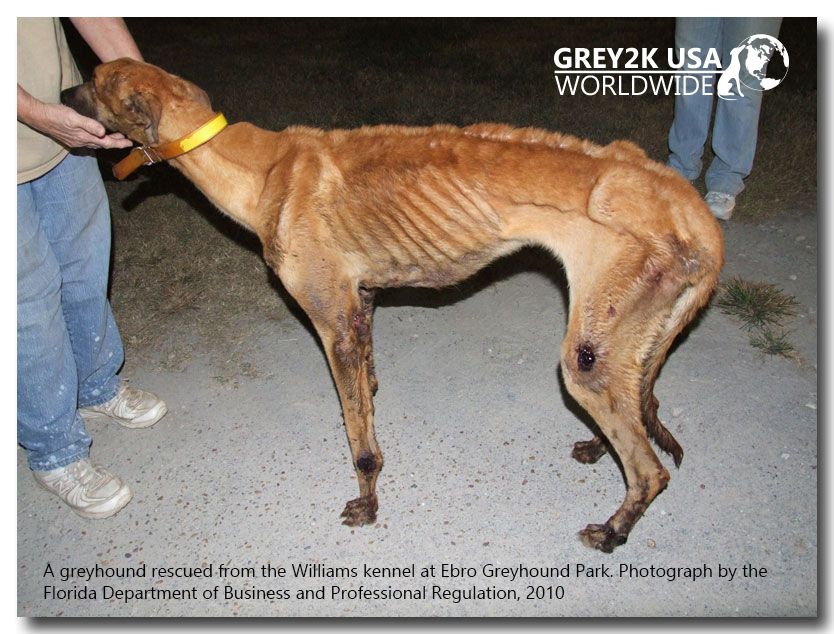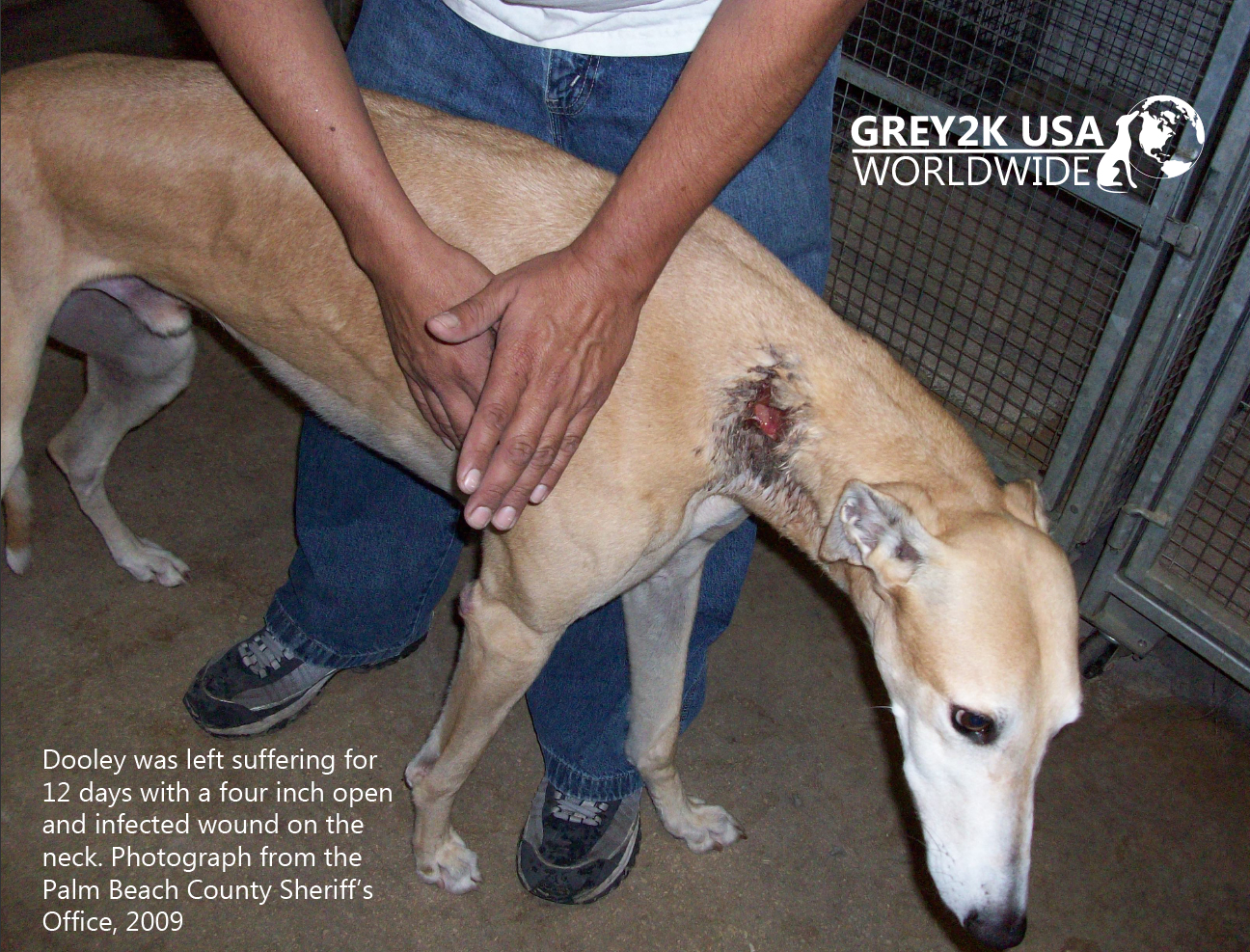The Cruel Reality of the Greyhound Racing Industry

2021 UPDATE - Legislation to End Dog Racing Introduced into U.S. Congress
The fight to end dog racing in the United States is advancing in Congress!
Introduced on May 19, 2021, by Rep. Tony Cardenas (D-CA-29), the Greyhound Protection Act, H.R.3335, would phase out greyhound racing in all 50 states. This bipartisan bill will also help greyhounds around the world, as it will stop Americans from gambling on foreign dog races. Now we need as many Congressional cosponsors as possible to help greyhounds cross the finish line!
U.S. Residents - Click Here to Email Your Representative and Urge Them to Support The Greyhound Protection Act!
FLORIDA VICTORY IN 2018: In November 2018, Amendment 13 passed in Florida, which had 11 of the 17 remaining dog tracks in the United States, outlawing commercial dog racing in the state! The ban goes into effect on Dec 31, 2020. Alabama, Arkansas, Iowa, Texas, and West Virginia are now the only states that have active dog racing tracks.
Since 2008, more than 80,000 young greyhounds have been registered to race. On average, a population of up to 1,000 dogs is required to operate a commercial racetrack. Greyhounds typically begin racing at eighteen months of age, and race until they are four. At the tracks, dogs are caged for twenty or more hours a day in warehouse-style kennel compounds.
It's a Dog's Life
Racing greyhounds are kept in cages, crates, or pens for approximately 22 hours each day. Most containers are as small as 3 x 3 feet and are not climate-controlled; the dogs suffer extreme weather conditions. They are let out of their cages only to relieve themselves, train, and race.Some greyhounds are kept muzzled constantly.
Racing greyhounds are typically fed raw, rancid meat, and denied basic veterinary care. They are often forced to race when they are injured or ill. Because the industry is not governed by the Animal Welfare Act, the Act's standards for the treatment and care of animals do not apply. Although greyhounds naturally live to be about 13 years old, the average lifespan of a racing greyhound is 3-4 years.
Racing greyhounds have repeatedly tested positive for serious drugs, including cocaine. Since 2008, at least sixteen race dogs have tested positive for cocaine in Florida and Alabama.
In 2010, Florida investigators discovered thirty-seven dead greyhounds during an inspection of the Ebro Greyhound Park kennel compound. The dogs had been starved to death and some had packing tape wound around their necks. Greyhound trainer Ronald Williams was arrested and faced a total of forty-two counts of felony animal cruelty. He was later sentenced to five years in prison for each count, to be served concurrently.
Greyhounds Suffer Serious Injuries
Since 2008, 11,722 greyhound injuries have been documented nationwide, including over 3,000 broken legs. Other reported injuries include fractured skulls, broken necks, and electrocutions. Alabama and Florida do not report greyhound injuries to the public, yet Florida is home to twelve of the remaining twenty-one tracks. Therefore, the total number of greyhound injuries is likely much higher. In addition, nearly 1,000 greyhound deaths have been documented since 2008. In Florida alone, state records show that a racing greyhound dies every three days.
- A three-year-old greyhound named LNB Night Mare was electrocuted during a race on March 9, 2014 at Tucson Greyhound Park in Arizona. She collided with another dog, fell into the electrified rail, and died before a small crowd of onlookers.
- On September 27, 2013, a one-year-old greyhound named Kells Crossfire hit the rail, broke her neck and was destroyed after running her last race at Gulf Greyhound Park in Texas.
- On July 11, 2013, a three-year-old greyhound named Scotty’s Buzz was destroyed after suffering a severe spinal injury during a race at Dubuque Greyhound Park in Iowa.
Greyhounds Are Abused
Since 2008, at least twenty-seven cases of greyhound cruelty and neglect have been documented, including cases of dogs denied veterinary care, dogs starved to death, and dogs living in poor kennel conditions. Other issues include female greyhounds shot up with anabolic steroids to block their natural reproductive cycles and greyhounds raw fed “4-D” meat from downed animals as a means of reducing costs.
- In West Virginia, a greyhound named Kiowa Dutch Girl suffered a broken leg on the morning of March 4, 2013 and was left to suffer in her cage until March 8. Kennel worker James E. Bloom, who witnessed the injury occur, described the leg as "bleeding, dangling" and admitted that she was left in her cage "whining” and “panting” in pain for days.
- On April 4, 2014, a one-year-old greyhound named Colt Maximus crushed her skull in a training race at Wheeling Island in West Virginia.
Bait Animals
Rabbits and other small animals are used as live bait to teach dogs to chase lures around the track. The rabbits are hung from horizontal poles and the dogs are encouraged to chase and kill them. Less aggressive dogs are sometimes placed in a cage with a small animal and not released or fed until they have killed it. In some states, training with live animals is illegal. However, industry insiders circumvent this legislation by sending the dogs to another state for training, as federal law allows greyhound racers to be shipped from state to state.
In September 2011 a Texas greyhound trainer named Timothy Norbert Titsworth surrendered his state license after he was caught on videotape using live rabbits to bait young greyhounds at his farm. Titsworth was charged with criminal cruelty to non-livestock animals; however, his case was dismissed in April of 2012.
Life After Racing

Once they finish racing, some greyhounds are put up for adoption, others are sent to breeding farms, and the fate of the remaining dogs remains unknown. The National Greyhound Association, which registers all greyhounds for racing, does not keep track of the dogs after they stop winning. Longtime Executive Director Gary Guccione admitted that there are “no cumulative annual records” of the ultimate fate of racing dogs.
When greyhounds become too sick or injured to race well, they may be:
- Killed immediately
- Abandoned
- Bred to produce more champions
- Sold to research facilities OR
- Sent to foreign racetracks, sometimes in underdeveloped countries
Ways in Which Retired Greyhounds Are Killed
- Gunshots
- Euthanasia
- Electrocution
- Gassing
- Abandonment
- Starvation
- Bludgeoning
THERE ARE 9 REMAINING STATES WHERE DOG RACING IS STILL LEGAL
The following states have closed all race tracks; however, there is no legislation that bans dog racing in these states:
- Connecticut
- Kansas
- Oregon
- Wisconsin
Dog racing is still legal and operational in the following states:
- Alabama
- Arkansas
- Iowa
- Texas
- West Virginia
Greyhound Racing is a Dying Industry
Between 2001 and 2012, the total amount gambled on greyhound racing nationwide declined by 66%. Track attendances continue to decline, and dog racing is being propped up by subsidies and mandates in several states. Florida is actually losing money on greyhound racing due to regulatory costs exceeding revenues. Specifically, tracks lost over $42 million on racing between June 2012 and November 2013.
International Greyhound Racing
Commercial greyhound racing also takes place in seven other countries: Australia, Ireland, Macau (SAR of China), Mexico, New Zealand, the United Kingdom, and Vietnam.
HOW YOU CAN HELP:
- U.S. Residents - Support the Greyhound Protection Act., H.R.3335. Click here to take action!
- Volunteer with a greyhound rescue group
- Adopt a retired greyhound; greyhounds make wonderful companion animals. Call 800-4-HOUNDS for more information.
- Distribute anti-racing brochures at a racetrack in your area
- Support legislation that bans greyhound racing
- Write letters to the editor of local newspapers objecting to greyhound racing
- Educate friends and family about the suffering involved in the greyhound racing industry
- Spay and neuter your pet; because of the overabundance of companion animals, there are not enough homes for retired greyhounds
Source: High Stakes: Greyhound Racing in the United States (Arlington, MA: GREY2K USA Worldwide, 2015)











